Psychological Age Assessment via Social Media Activities (IGNOU)
VerifiedAdded on 2022/10/13
|7
|1745
|7
Project
AI Summary
This project explores the relationship between social media activities and psychological age. The research investigates how online interactions, content creation, and sharing influence an individual's psychological age, which is based on behavior and feelings, as opposed to chronological age. The study employs a correlation research design and utilizes a non-probability, purposeful sampling method to collect data from 300 participants, using tools like ANOVA, correlation, and SPSS for analysis. The project aims to measure the impact of social media on psychological age, focusing on the positive effects and employing psychological tests and social scales, such as Likert scales, to assess the influence of social media activities on different age groups. The project provides a comprehensive overview of the methodology, including research questions, objectives, hypotheses, and operational definitions, along with a review of relevant literature discussing the influence of social media on adolescence, intelligence, creativity, and social networking.
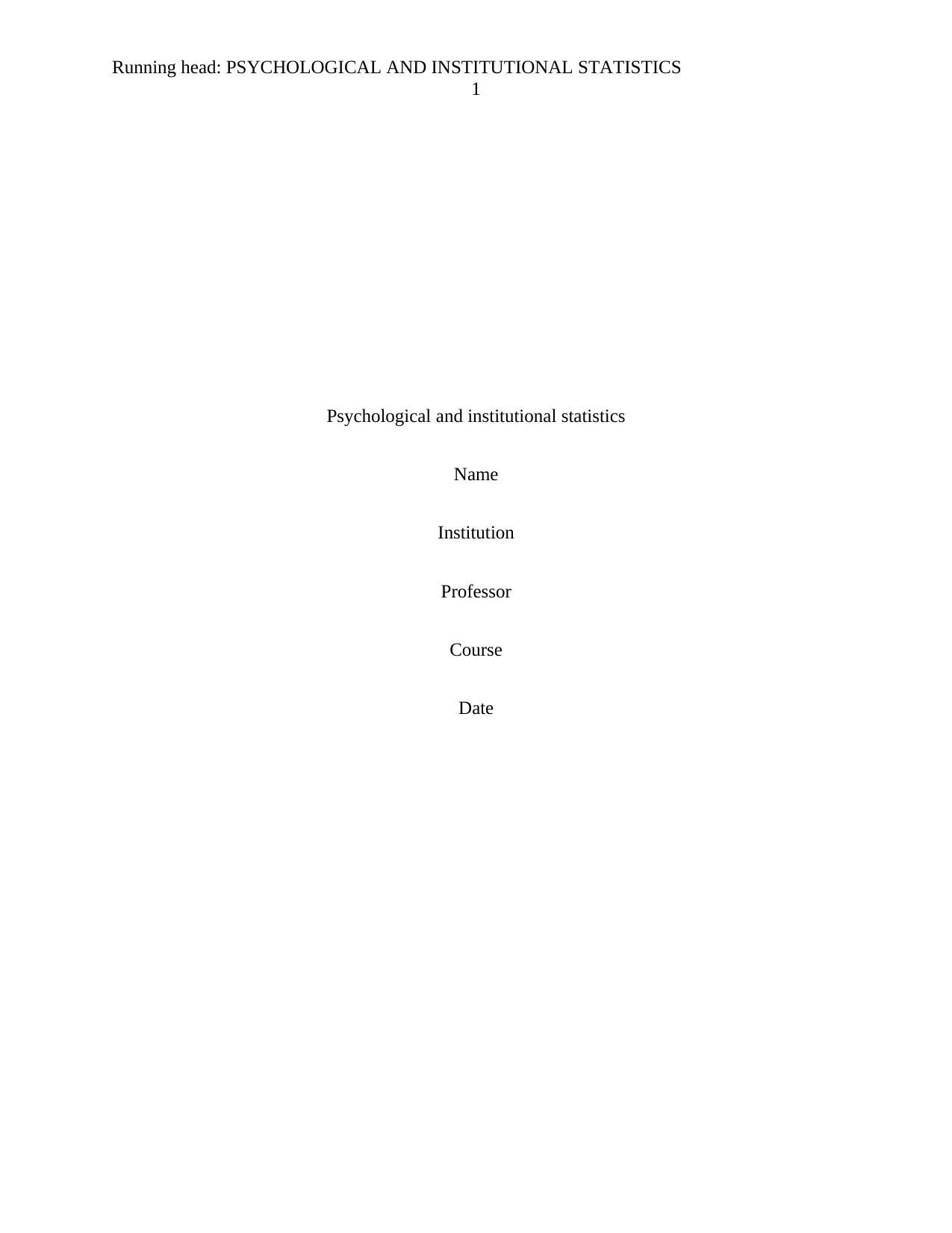
Running head: PSYCHOLOGICAL AND INSTITUTIONAL STATISTICS
1
Psychological and institutional statistics
Name
Institution
Professor
Course
Date
1
Psychological and institutional statistics
Name
Institution
Professor
Course
Date
Paraphrase This Document
Need a fresh take? Get an instant paraphrase of this document with our AI Paraphraser
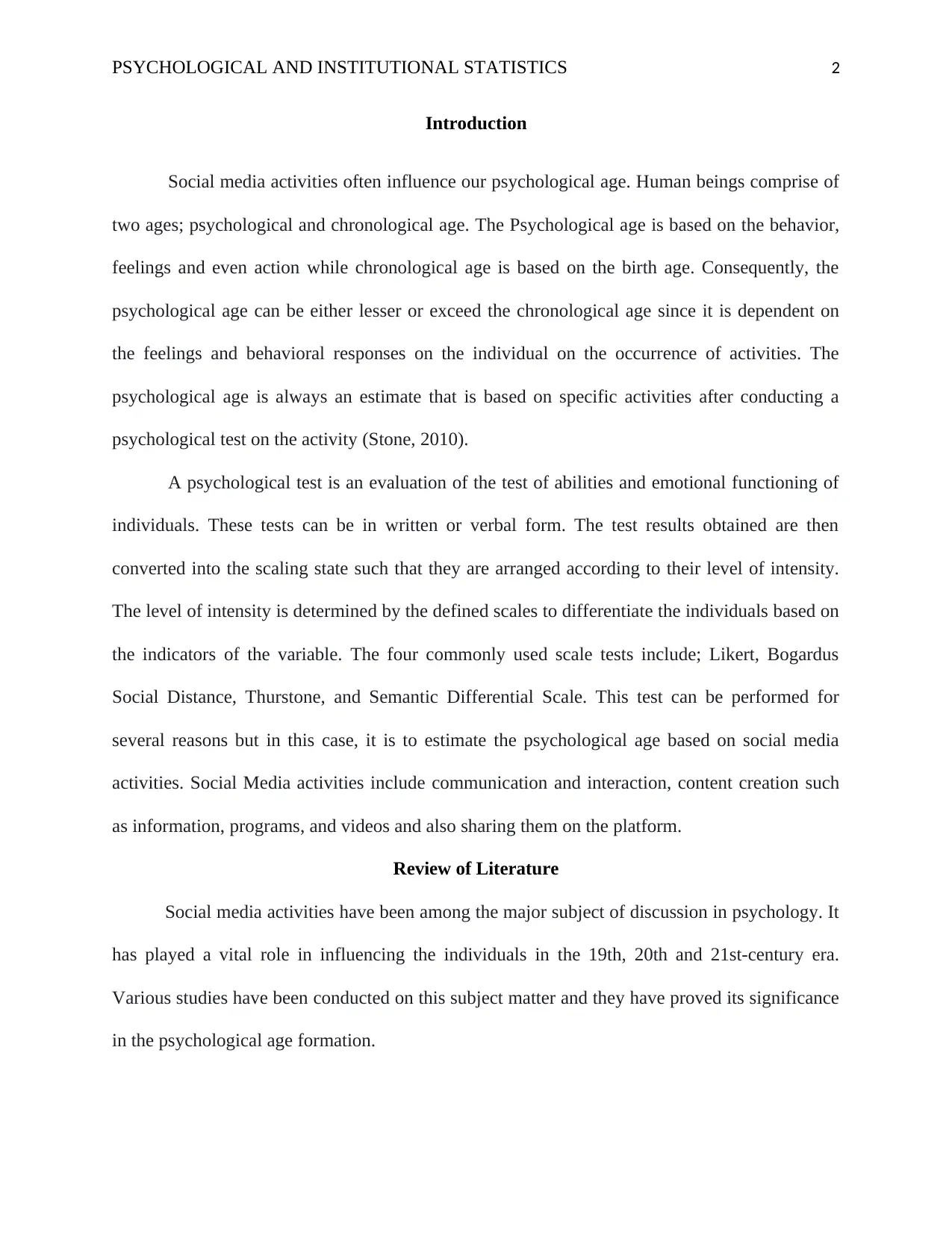
PSYCHOLOGICAL AND INSTITUTIONAL STATISTICS 2
Introduction
Social media activities often influence our psychological age. Human beings comprise of
two ages; psychological and chronological age. The Psychological age is based on the behavior,
feelings and even action while chronological age is based on the birth age. Consequently, the
psychological age can be either lesser or exceed the chronological age since it is dependent on
the feelings and behavioral responses on the individual on the occurrence of activities. The
psychological age is always an estimate that is based on specific activities after conducting a
psychological test on the activity (Stone, 2010).
A psychological test is an evaluation of the test of abilities and emotional functioning of
individuals. These tests can be in written or verbal form. The test results obtained are then
converted into the scaling state such that they are arranged according to their level of intensity.
The level of intensity is determined by the defined scales to differentiate the individuals based on
the indicators of the variable. The four commonly used scale tests include; Likert, Bogardus
Social Distance, Thurstone, and Semantic Differential Scale. This test can be performed for
several reasons but in this case, it is to estimate the psychological age based on social media
activities. Social Media activities include communication and interaction, content creation such
as information, programs, and videos and also sharing them on the platform.
Review of Literature
Social media activities have been among the major subject of discussion in psychology. It
has played a vital role in influencing the individuals in the 19th, 20th and 21st-century era.
Various studies have been conducted on this subject matter and they have proved its significance
in the psychological age formation.
Introduction
Social media activities often influence our psychological age. Human beings comprise of
two ages; psychological and chronological age. The Psychological age is based on the behavior,
feelings and even action while chronological age is based on the birth age. Consequently, the
psychological age can be either lesser or exceed the chronological age since it is dependent on
the feelings and behavioral responses on the individual on the occurrence of activities. The
psychological age is always an estimate that is based on specific activities after conducting a
psychological test on the activity (Stone, 2010).
A psychological test is an evaluation of the test of abilities and emotional functioning of
individuals. These tests can be in written or verbal form. The test results obtained are then
converted into the scaling state such that they are arranged according to their level of intensity.
The level of intensity is determined by the defined scales to differentiate the individuals based on
the indicators of the variable. The four commonly used scale tests include; Likert, Bogardus
Social Distance, Thurstone, and Semantic Differential Scale. This test can be performed for
several reasons but in this case, it is to estimate the psychological age based on social media
activities. Social Media activities include communication and interaction, content creation such
as information, programs, and videos and also sharing them on the platform.
Review of Literature
Social media activities have been among the major subject of discussion in psychology. It
has played a vital role in influencing the individuals in the 19th, 20th and 21st-century era.
Various studies have been conducted on this subject matter and they have proved its significance
in the psychological age formation.
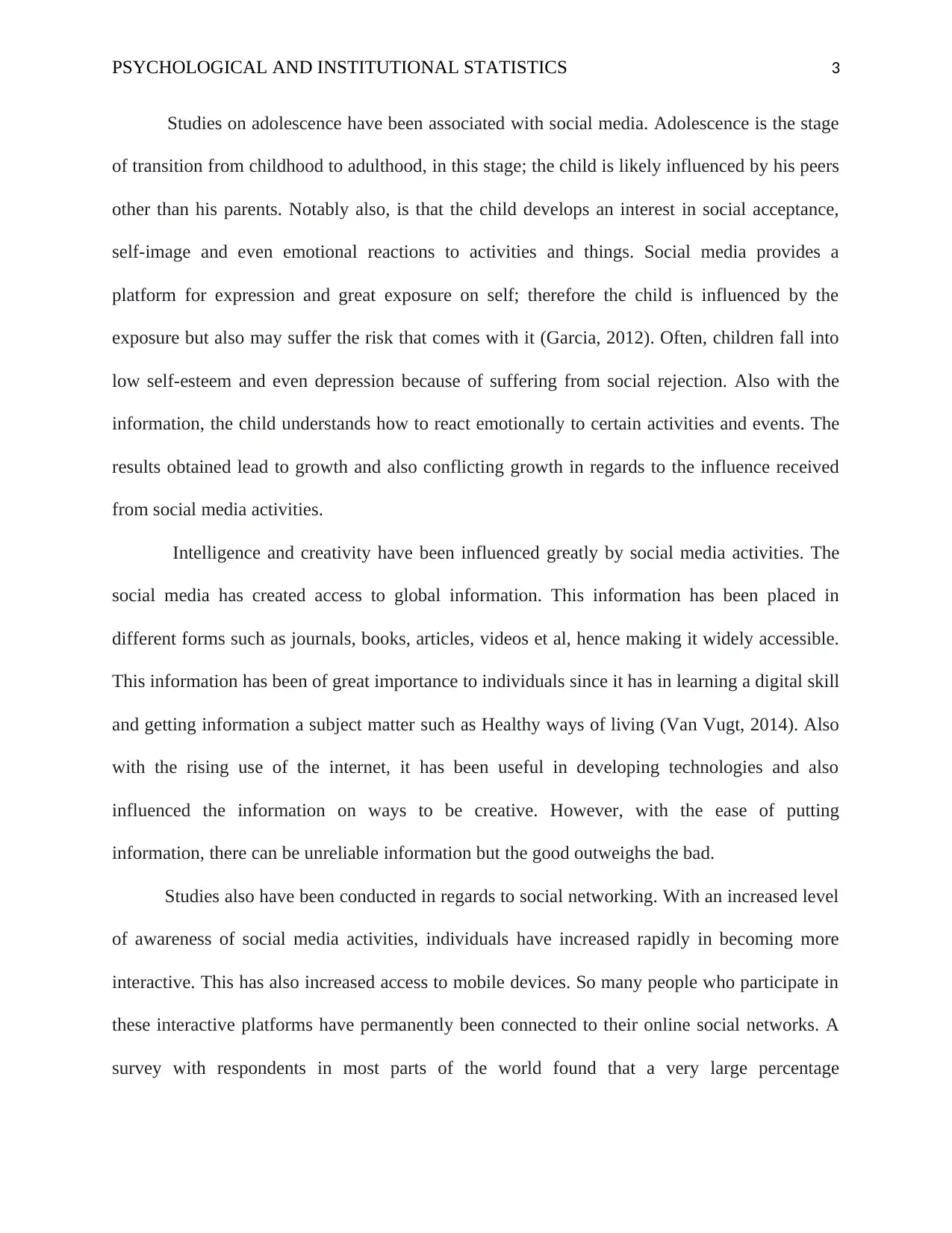
PSYCHOLOGICAL AND INSTITUTIONAL STATISTICS 3
Studies on adolescence have been associated with social media. Adolescence is the stage
of transition from childhood to adulthood, in this stage; the child is likely influenced by his peers
other than his parents. Notably also, is that the child develops an interest in social acceptance,
self-image and even emotional reactions to activities and things. Social media provides a
platform for expression and great exposure on self; therefore the child is influenced by the
exposure but also may suffer the risk that comes with it (Garcia, 2012). Often, children fall into
low self-esteem and even depression because of suffering from social rejection. Also with the
information, the child understands how to react emotionally to certain activities and events. The
results obtained lead to growth and also conflicting growth in regards to the influence received
from social media activities.
Intelligence and creativity have been influenced greatly by social media activities. The
social media has created access to global information. This information has been placed in
different forms such as journals, books, articles, videos et al, hence making it widely accessible.
This information has been of great importance to individuals since it has in learning a digital skill
and getting information a subject matter such as Healthy ways of living (Van Vugt, 2014). Also
with the rising use of the internet, it has been useful in developing technologies and also
influenced the information on ways to be creative. However, with the ease of putting
information, there can be unreliable information but the good outweighs the bad.
Studies also have been conducted in regards to social networking. With an increased level
of awareness of social media activities, individuals have increased rapidly in becoming more
interactive. This has also increased access to mobile devices. So many people who participate in
these interactive platforms have permanently been connected to their online social networks. A
survey with respondents in most parts of the world found that a very large percentage
Studies on adolescence have been associated with social media. Adolescence is the stage
of transition from childhood to adulthood, in this stage; the child is likely influenced by his peers
other than his parents. Notably also, is that the child develops an interest in social acceptance,
self-image and even emotional reactions to activities and things. Social media provides a
platform for expression and great exposure on self; therefore the child is influenced by the
exposure but also may suffer the risk that comes with it (Garcia, 2012). Often, children fall into
low self-esteem and even depression because of suffering from social rejection. Also with the
information, the child understands how to react emotionally to certain activities and events. The
results obtained lead to growth and also conflicting growth in regards to the influence received
from social media activities.
Intelligence and creativity have been influenced greatly by social media activities. The
social media has created access to global information. This information has been placed in
different forms such as journals, books, articles, videos et al, hence making it widely accessible.
This information has been of great importance to individuals since it has in learning a digital skill
and getting information a subject matter such as Healthy ways of living (Van Vugt, 2014). Also
with the rising use of the internet, it has been useful in developing technologies and also
influenced the information on ways to be creative. However, with the ease of putting
information, there can be unreliable information but the good outweighs the bad.
Studies also have been conducted in regards to social networking. With an increased level
of awareness of social media activities, individuals have increased rapidly in becoming more
interactive. This has also increased access to mobile devices. So many people who participate in
these interactive platforms have permanently been connected to their online social networks. A
survey with respondents in most parts of the world found that a very large percentage
⊘ This is a preview!⊘
Do you want full access?
Subscribe today to unlock all pages.

Trusted by 1+ million students worldwide
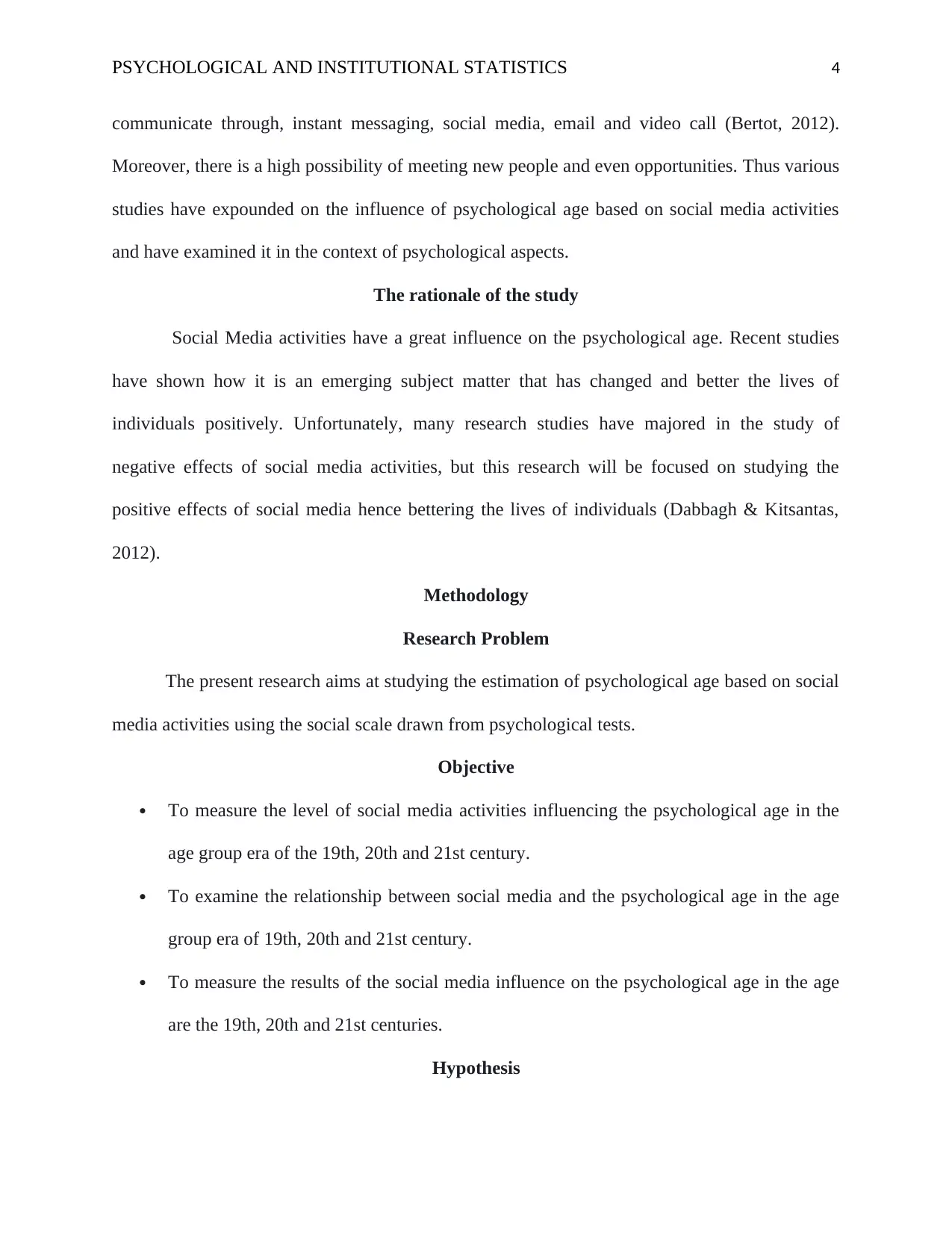
PSYCHOLOGICAL AND INSTITUTIONAL STATISTICS 4
communicate through, instant messaging, social media, email and video call (Bertot, 2012).
Moreover, there is a high possibility of meeting new people and even opportunities. Thus various
studies have expounded on the influence of psychological age based on social media activities
and have examined it in the context of psychological aspects.
The rationale of the study
Social Media activities have a great influence on the psychological age. Recent studies
have shown how it is an emerging subject matter that has changed and better the lives of
individuals positively. Unfortunately, many research studies have majored in the study of
negative effects of social media activities, but this research will be focused on studying the
positive effects of social media hence bettering the lives of individuals (Dabbagh & Kitsantas,
2012).
Methodology
Research Problem
The present research aims at studying the estimation of psychological age based on social
media activities using the social scale drawn from psychological tests.
Objective
To measure the level of social media activities influencing the psychological age in the
age group era of the 19th, 20th and 21st century.
To examine the relationship between social media and the psychological age in the age
group era of 19th, 20th and 21st century.
To measure the results of the social media influence on the psychological age in the age
are the 19th, 20th and 21st centuries.
Hypothesis
communicate through, instant messaging, social media, email and video call (Bertot, 2012).
Moreover, there is a high possibility of meeting new people and even opportunities. Thus various
studies have expounded on the influence of psychological age based on social media activities
and have examined it in the context of psychological aspects.
The rationale of the study
Social Media activities have a great influence on the psychological age. Recent studies
have shown how it is an emerging subject matter that has changed and better the lives of
individuals positively. Unfortunately, many research studies have majored in the study of
negative effects of social media activities, but this research will be focused on studying the
positive effects of social media hence bettering the lives of individuals (Dabbagh & Kitsantas,
2012).
Methodology
Research Problem
The present research aims at studying the estimation of psychological age based on social
media activities using the social scale drawn from psychological tests.
Objective
To measure the level of social media activities influencing the psychological age in the
age group era of the 19th, 20th and 21st century.
To examine the relationship between social media and the psychological age in the age
group era of 19th, 20th and 21st century.
To measure the results of the social media influence on the psychological age in the age
are the 19th, 20th and 21st centuries.
Hypothesis
Paraphrase This Document
Need a fresh take? Get an instant paraphrase of this document with our AI Paraphraser
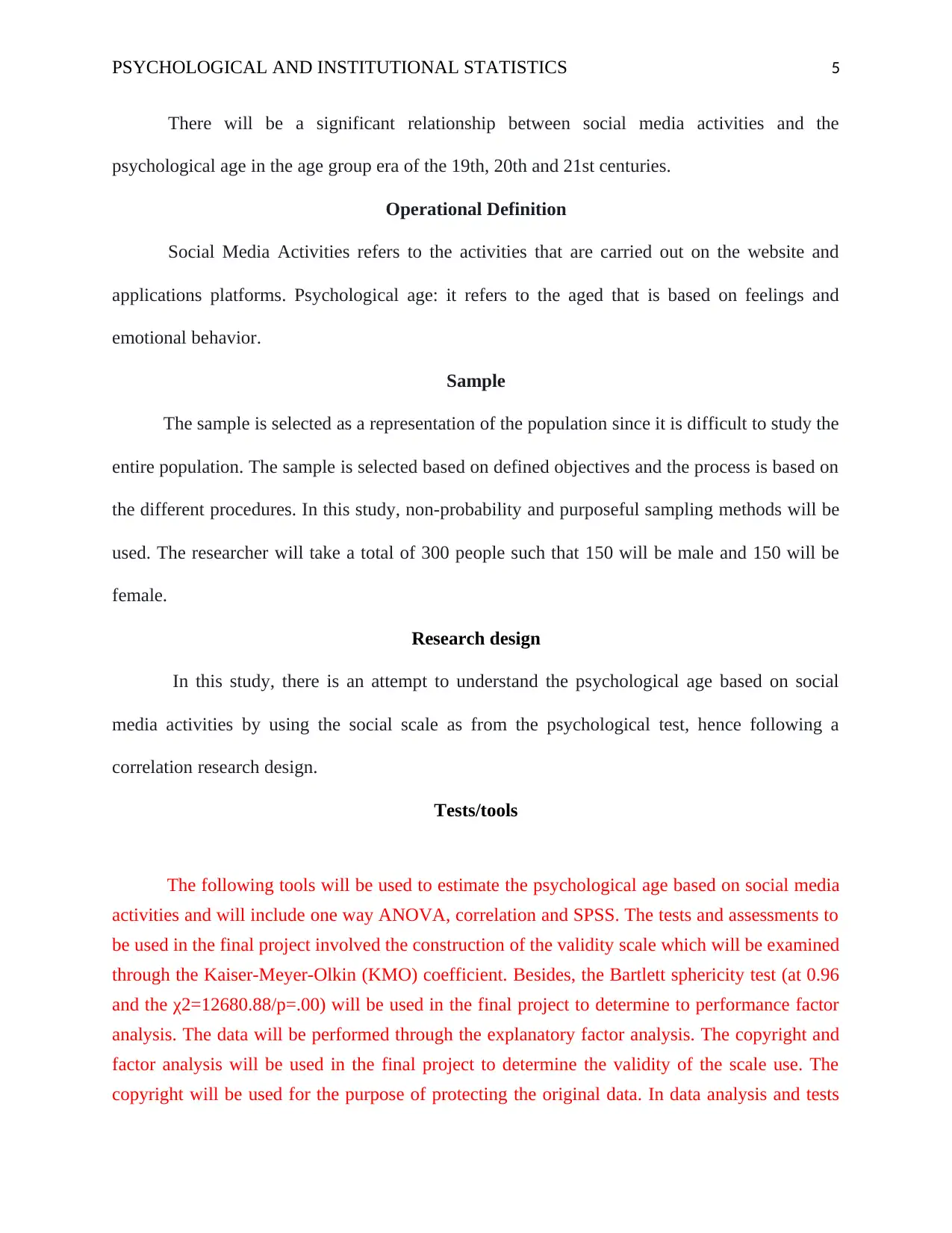
PSYCHOLOGICAL AND INSTITUTIONAL STATISTICS 5
There will be a significant relationship between social media activities and the
psychological age in the age group era of the 19th, 20th and 21st centuries.
Operational Definition
Social Media Activities refers to the activities that are carried out on the website and
applications platforms. Psychological age: it refers to the aged that is based on feelings and
emotional behavior.
Sample
The sample is selected as a representation of the population since it is difficult to study the
entire population. The sample is selected based on defined objectives and the process is based on
the different procedures. In this study, non-probability and purposeful sampling methods will be
used. The researcher will take a total of 300 people such that 150 will be male and 150 will be
female.
Research design
In this study, there is an attempt to understand the psychological age based on social
media activities by using the social scale as from the psychological test, hence following a
correlation research design.
Tests/tools
The following tools will be used to estimate the psychological age based on social media
activities and will include one way ANOVA, correlation and SPSS. The tests and assessments to
be used in the final project involved the construction of the validity scale which will be examined
through the Kaiser-Meyer-Olkin (KMO) coefficient. Besides, the Bartlett sphericity test (at 0.96
and the χ2=12680.88/p=.00) will be used in the final project to determine to performance factor
analysis. The data will be performed through the explanatory factor analysis. The copyright and
factor analysis will be used in the final project to determine the validity of the scale use. The
copyright will be used for the purpose of protecting the original data. In data analysis and tests
There will be a significant relationship between social media activities and the
psychological age in the age group era of the 19th, 20th and 21st centuries.
Operational Definition
Social Media Activities refers to the activities that are carried out on the website and
applications platforms. Psychological age: it refers to the aged that is based on feelings and
emotional behavior.
Sample
The sample is selected as a representation of the population since it is difficult to study the
entire population. The sample is selected based on defined objectives and the process is based on
the different procedures. In this study, non-probability and purposeful sampling methods will be
used. The researcher will take a total of 300 people such that 150 will be male and 150 will be
female.
Research design
In this study, there is an attempt to understand the psychological age based on social
media activities by using the social scale as from the psychological test, hence following a
correlation research design.
Tests/tools
The following tools will be used to estimate the psychological age based on social media
activities and will include one way ANOVA, correlation and SPSS. The tests and assessments to
be used in the final project involved the construction of the validity scale which will be examined
through the Kaiser-Meyer-Olkin (KMO) coefficient. Besides, the Bartlett sphericity test (at 0.96
and the χ2=12680.88/p=.00) will be used in the final project to determine to performance factor
analysis. The data will be performed through the explanatory factor analysis. The copyright and
factor analysis will be used in the final project to determine the validity of the scale use. The
copyright will be used for the purpose of protecting the original data. In data analysis and tests
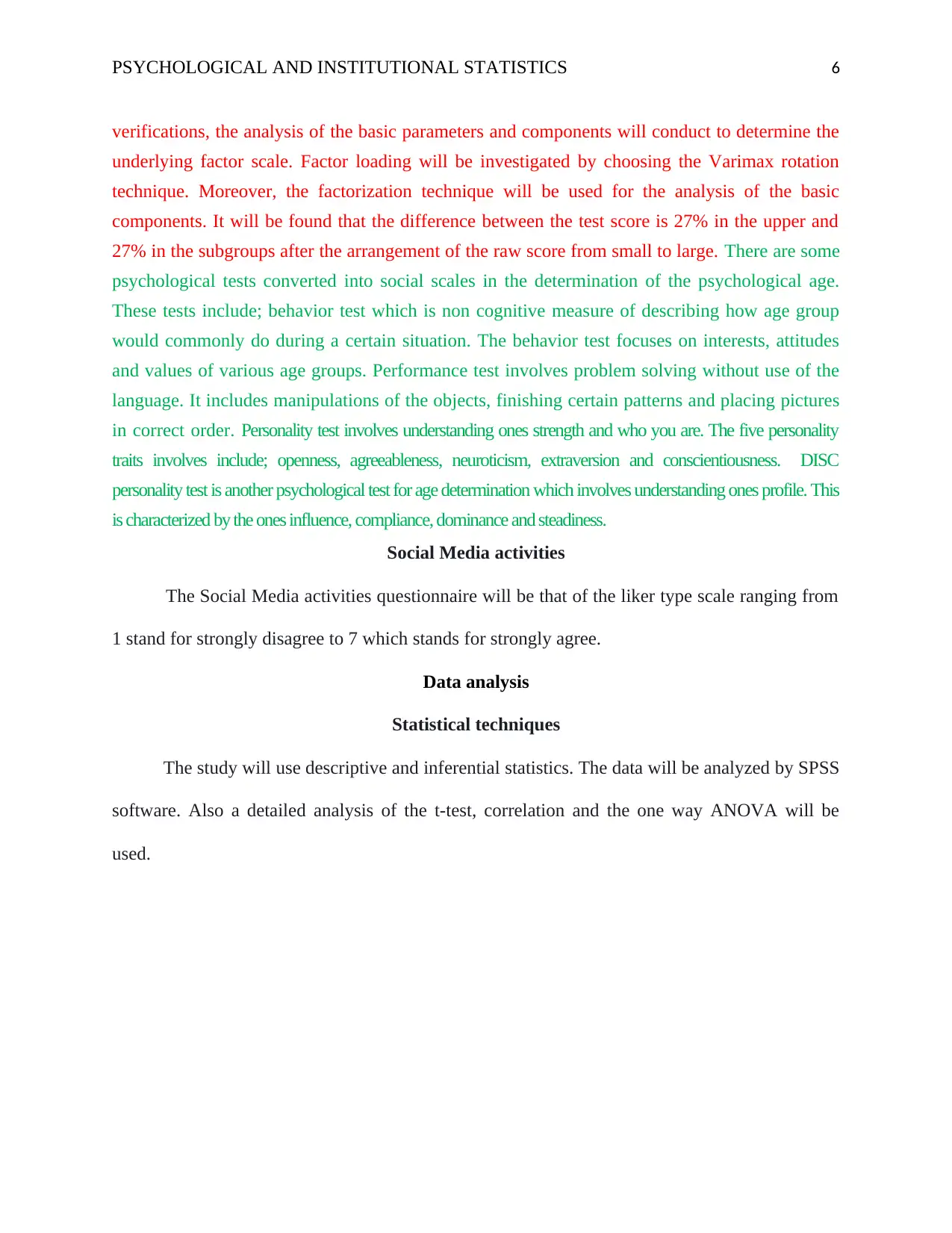
PSYCHOLOGICAL AND INSTITUTIONAL STATISTICS 6
verifications, the analysis of the basic parameters and components will conduct to determine the
underlying factor scale. Factor loading will be investigated by choosing the Varimax rotation
technique. Moreover, the factorization technique will be used for the analysis of the basic
components. It will be found that the difference between the test score is 27% in the upper and
27% in the subgroups after the arrangement of the raw score from small to large. There are some
psychological tests converted into social scales in the determination of the psychological age.
These tests include; behavior test which is non cognitive measure of describing how age group
would commonly do during a certain situation. The behavior test focuses on interests, attitudes
and values of various age groups. Performance test involves problem solving without use of the
language. It includes manipulations of the objects, finishing certain patterns and placing pictures
in correct order. Personality test involves understanding ones strength and who you are. The five personality
traits involves include; openness, agreeableness, neuroticism, extraversion and conscientiousness. DISC
personality test is another psychological test for age determination which involves understanding ones profile. This
is characterized by the ones influence, compliance, dominance and steadiness.
Social Media activities
The Social Media activities questionnaire will be that of the liker type scale ranging from
1 stand for strongly disagree to 7 which stands for strongly agree.
Data analysis
Statistical techniques
The study will use descriptive and inferential statistics. The data will be analyzed by SPSS
software. Also a detailed analysis of the t-test, correlation and the one way ANOVA will be
used.
verifications, the analysis of the basic parameters and components will conduct to determine the
underlying factor scale. Factor loading will be investigated by choosing the Varimax rotation
technique. Moreover, the factorization technique will be used for the analysis of the basic
components. It will be found that the difference between the test score is 27% in the upper and
27% in the subgroups after the arrangement of the raw score from small to large. There are some
psychological tests converted into social scales in the determination of the psychological age.
These tests include; behavior test which is non cognitive measure of describing how age group
would commonly do during a certain situation. The behavior test focuses on interests, attitudes
and values of various age groups. Performance test involves problem solving without use of the
language. It includes manipulations of the objects, finishing certain patterns and placing pictures
in correct order. Personality test involves understanding ones strength and who you are. The five personality
traits involves include; openness, agreeableness, neuroticism, extraversion and conscientiousness. DISC
personality test is another psychological test for age determination which involves understanding ones profile. This
is characterized by the ones influence, compliance, dominance and steadiness.
Social Media activities
The Social Media activities questionnaire will be that of the liker type scale ranging from
1 stand for strongly disagree to 7 which stands for strongly agree.
Data analysis
Statistical techniques
The study will use descriptive and inferential statistics. The data will be analyzed by SPSS
software. Also a detailed analysis of the t-test, correlation and the one way ANOVA will be
used.
⊘ This is a preview!⊘
Do you want full access?
Subscribe today to unlock all pages.

Trusted by 1+ million students worldwide
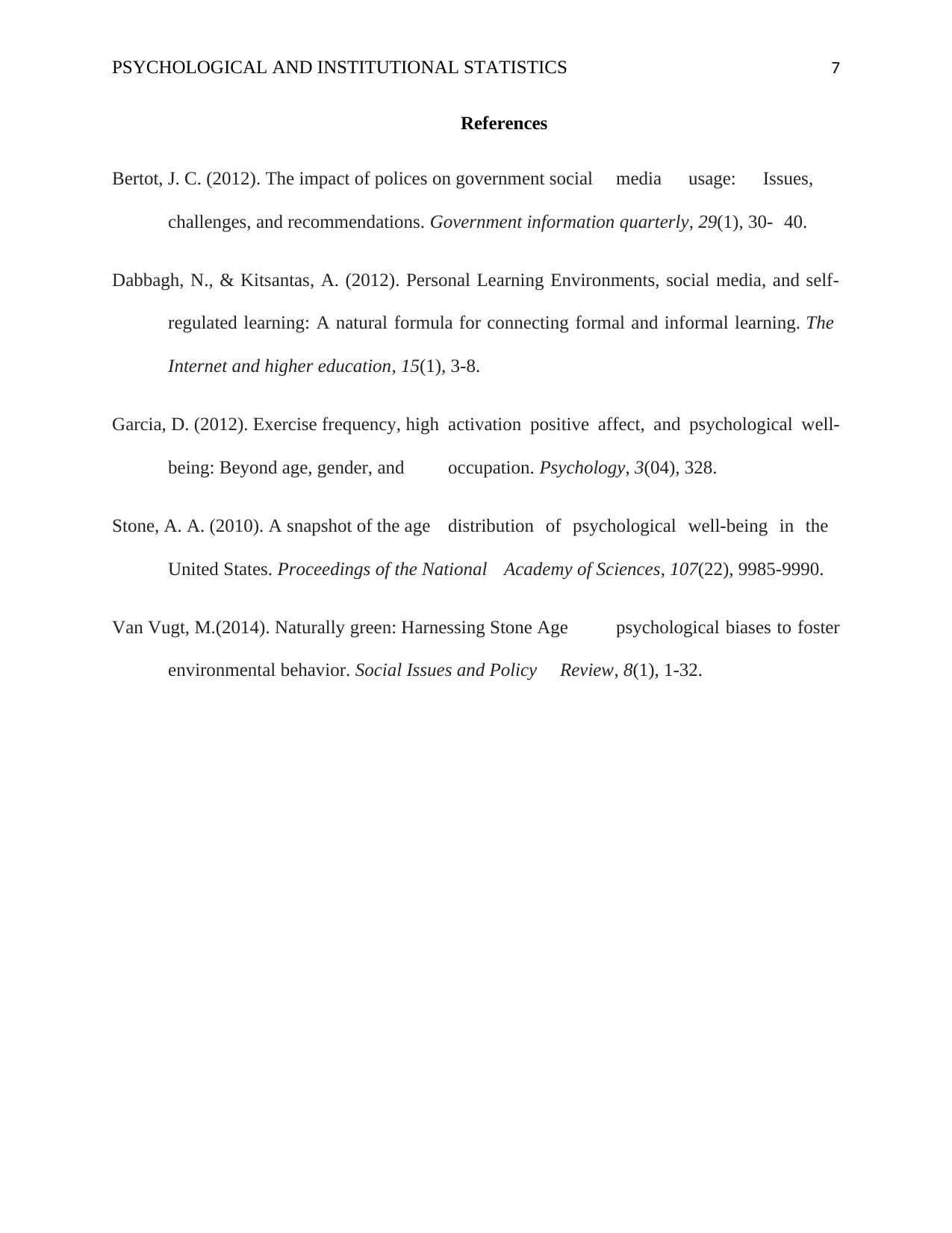
PSYCHOLOGICAL AND INSTITUTIONAL STATISTICS 7
References
Bertot, J. C. (2012). The impact of polices on government social media usage: Issues,
challenges, and recommendations. Government information quarterly, 29(1), 30- 40.
Dabbagh, N., & Kitsantas, A. (2012). Personal Learning Environments, social media, and self-
regulated learning: A natural formula for connecting formal and informal learning. The
Internet and higher education, 15(1), 3-8.
Garcia, D. (2012). Exercise frequency, high activation positive affect, and psychological well-
being: Beyond age, gender, and occupation. Psychology, 3(04), 328.
Stone, A. A. (2010). A snapshot of the age distribution of psychological well-being in the
United States. Proceedings of the National Academy of Sciences, 107(22), 9985-9990.
Van Vugt, M.(2014). Naturally green: Harnessing Stone Age psychological biases to foster
environmental behavior. Social Issues and Policy Review, 8(1), 1-32.
References
Bertot, J. C. (2012). The impact of polices on government social media usage: Issues,
challenges, and recommendations. Government information quarterly, 29(1), 30- 40.
Dabbagh, N., & Kitsantas, A. (2012). Personal Learning Environments, social media, and self-
regulated learning: A natural formula for connecting formal and informal learning. The
Internet and higher education, 15(1), 3-8.
Garcia, D. (2012). Exercise frequency, high activation positive affect, and psychological well-
being: Beyond age, gender, and occupation. Psychology, 3(04), 328.
Stone, A. A. (2010). A snapshot of the age distribution of psychological well-being in the
United States. Proceedings of the National Academy of Sciences, 107(22), 9985-9990.
Van Vugt, M.(2014). Naturally green: Harnessing Stone Age psychological biases to foster
environmental behavior. Social Issues and Policy Review, 8(1), 1-32.
1 out of 7
Related Documents
Your All-in-One AI-Powered Toolkit for Academic Success.
+13062052269
info@desklib.com
Available 24*7 on WhatsApp / Email
![[object Object]](/_next/static/media/star-bottom.7253800d.svg)
Unlock your academic potential
Copyright © 2020–2025 A2Z Services. All Rights Reserved. Developed and managed by ZUCOL.





